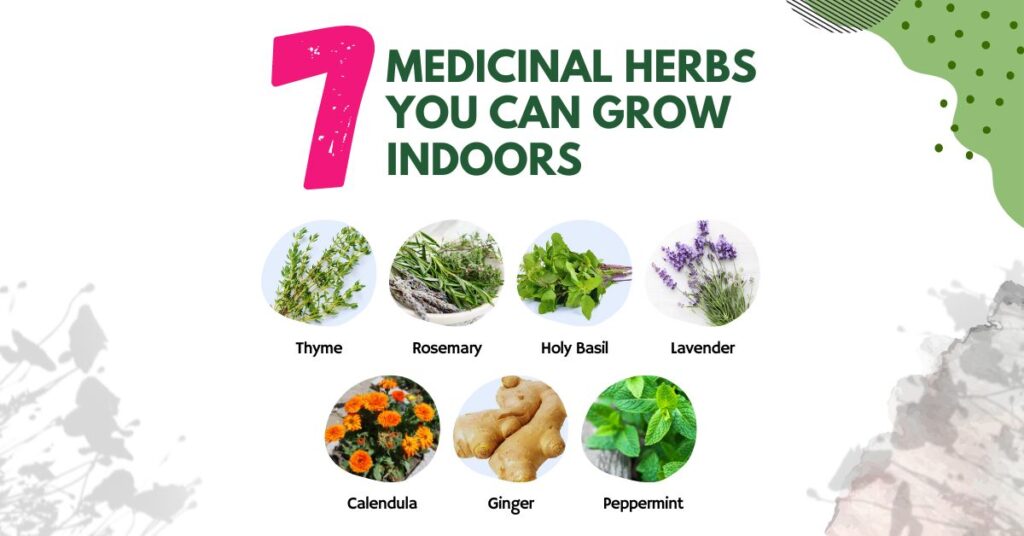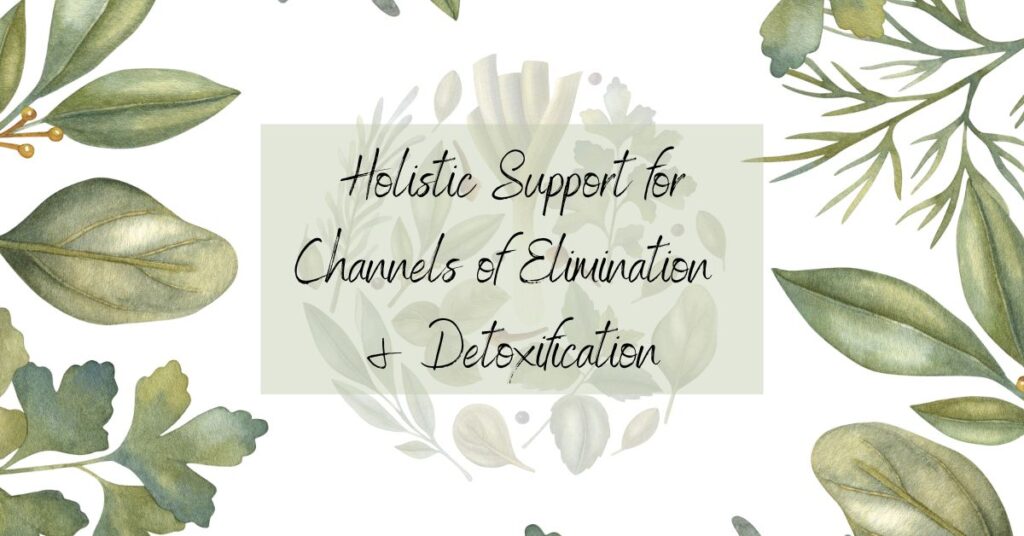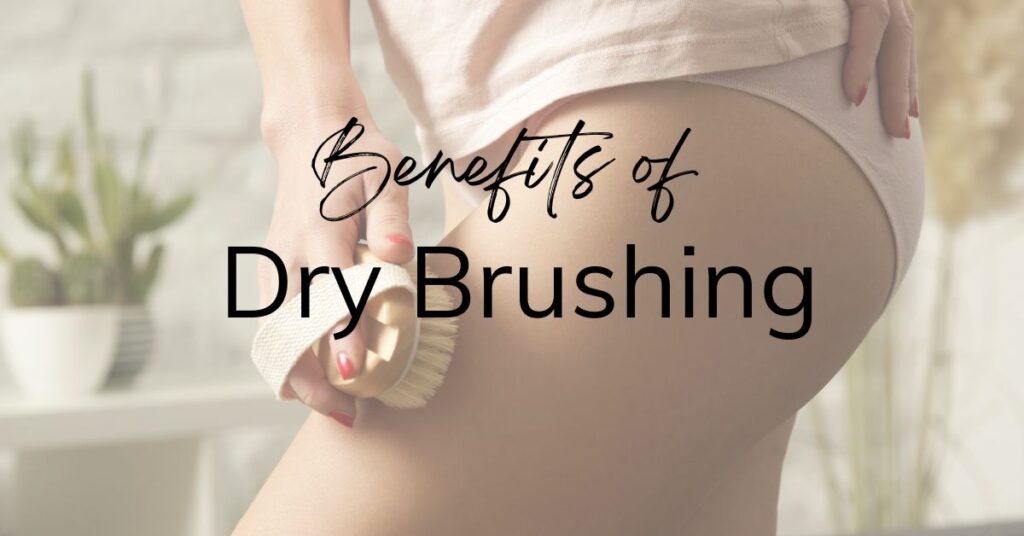Using herbs medicinally is as easy as ordering essential oils from your favorite resource. If you’re ready to take it to the next level, let’s dive into some common herbs to grow indoors!

The volatile compounds in herbs can be made into any number of products to eat, drink, or apply to your skin. What you create with your homegrown herbs will depend on what you wish to use it for.
Most essential oil extraction methods are too complex for home use, but decoctions and infusions are as simple as boiling water for tea.
Medicinal Herbs To Grow Indoors
So let’s check out my favorite 7 medicinal herbs to grow indoors!
Thyme
• Sun: 6+ hours direct, will tolerate indirect
• Light Supplement: Unnecessary
• Container: Clay or terra cotta
• Growth Medium: Enriched potting soil mixed with sand and perlite
• Fertilizer: Lightly fertilize every two weeks
• Moisture: Water fully only when soil has completely dried
Thyme essential oil has been shown to improve respiratory symptoms, especially sore throat. You can get the same effect if you use your thyme to make infused honey. The honey soothes your throat, and fully coats it with the infused thyme compounds.

Rosemary
• Sun: 8 hours full sun
• Light Supplement: Yes in winter or chronically low light
• Container: Same height as the above-ground plant growth
• Growth Medium: Very well-draining such as cactus soil enriched with compost
• Fertilizer: No
• Water: Place pot over a drainage pan with gravel in it and keep water in the pan. Mist the foliage once or twice per week. Only water the soil every couple of weeks, but keep the plant in humid conditions.
Rosemary can be used in tea or as an ingredient for products to clarify your skin and hair. It has been called the “herb of remembrance” for its effects supporting memory and cognition.
Its antimicrobial properties are so strong, that its incense was historically used to fumigate hospitals. Famously, the popular “thieves oil” essential oil blend was used to protect against bubonic plague by thieves who stole from plague victims’ homes.

Holy Basil
• Sun: 4-6 hours direct sun
• Light Supplement: Unnecessary if you have a South-facing window
• Container: At least 24” tall pot
• Growth Medium: Rich, moisture-retaining potting soil
• Fertilizer: Unnecessary
• Moisture: Well drained but consistently moist
These plants of Indian origin are popular in digestive teas, and they contain compounds that support cognition and mental acuity. Holy basil also appears to relieve the physiological symptoms of chronic stress including high blood pressure and high cholesterol.

Lavender
• Sun: 4-6 hours direct sunlight
• Light Supplement: Unnecessary
• Container: Clay or terra cotta
• Growth Medium: Loose, aerated, gravelly
• Fertilizer: Occasional lime or alkaline fertilizer
• Moisture: Low with quick drainage
The scent of fresh lavender famously calms and soothes the mind. Simply brush the leaves and flowers for instant peace. It is also a powerful antimicrobial plant. A hot lavender decoction like tea can open stuffy sinuses. Lavender infusion in salves and balms can be used on burns, acne, and other skin injuries.

Calendula
• Sun: Minimal direct light, highly tolerant
• Light Supplement: Unnecessary
• Container: Deep pot, at least 18” tall
• Growth Medium: Potting mix
• Fertilizer: Unnecessary
• Moisture: Moderate, somewhat tolerant of excess
Be sure to test a small skin patch to make sure you aren’t allergic. According to Breina Gidseg at Ora’s Amazing Herbal:
“Calendula is often used topically for ailments and irritation of the skin and mucous membranes such as itching, contact dermatitis and heat rash. It is used to reduce swelling and inflammation, including of the mouth and throat, as well as to relieve the pain of hemorrhoids and proctitis and to heal abrasions. It has a history of being used for detoxifying the gallbladder and liver when taken internally as well as to treat fevers and prevent muscle spasms (including menstrual cramps).”
Breina Gidseg at Ora’s Amazing Herbal

Ginger
• Sun: Direct
• Light Supplement: Yes in winter or chronically low light
• Container: At least 2-gallon pot
• Growth Medium: Potting mix
• Fertilizer: Weekly water-soluble plant food, monthly compost
• Moisture: High
Ginger is the hands-down best digestive aid in the herbal world. Practically any stomach discomfort or illness will improve with ginger. According to Jaclyn London, MS, RD, CDN, ginger’s anti-inflammatory properties and powerful effects on digestion may also protect against diabetes and support weight loss.

Peppermint
• Sun: Indirect
• Light Supplement: Unnecessary
• Container: Wide and shallow plastic pot
• Growth Medium: Moisture retaining potting mix
• Fertilizer: Unnecessary
• Moisture: Consistently damp but well-drained
Peppermint contains the most menthol compared to other mint varieties, which makes it a great choice for medicinal uses. Mint salves and balms are cooling, powerful migraine relievers when applied to the forehead. Mint tea is an excellent digestive aid. A strong batch of chilled mint tea can be applied to the skin to soothe sunburn, and stalks of mint around your windowsills or pet bedding can repel insects.

My Personal Indoor Herb Garden
When I first started on my journey of deciding which medical herbs to grow indoors in my kitchen, I decided on 9. I have 2 varieties of lavender, peppermint, thyme, oregano, rosemary, cilantro, parsley and sage.
I often have basil, but I do not have that one at the moment because I had transplanted my herbs outdoors and wanted to leave them for the new owners. No more outdoor herbs for me! So I started fresh. Still building it back up.
I keep them in my window sill and they do lovely! There are SO many more medical herbs to grow indoors than are mentioned here, but this is a good starting point!

References:
[1] https://sites.psu.edu/siowfa15/2015/09/17/does-peppermint-make-you-smarter/
[2] http://wildfoodsandmedicines.com/rosemary/
[3] https://www.goodhousekeeping.com/health/diet-nutrition/a46886/health-benefits-of-ginger/
[4] https://www.almanac.com/news/natural-health-home-tips/benefits-of-mint-plant
Disclaimer: These statements have not been evaluated by the Food and Drug Administration. The contents of this article, made available via Holistic Fit For Life (Holistic Fit LLC), are for informational purposes only and do not constitute medical advice. The Content presented here is not intended to be a substitute for professional medical advice, diagnosis, or treatment. Always seek the advice of a qualified healthcare provider with any questions you may have regarding a medical condition. If you think you may be suffering from any medical condition, you should seek immediate medical attention. You should never delay seeking medical advice, disregard medical advice, or discontinue medical treatment because of information provided by Holistic Fit For Life (Holistic Fit LLC). Reliance on any information provided by this article is solely at your own risk. And, of course, never use an herb or essential oil without first reading the label, doing your research, or checking with a local expert.





